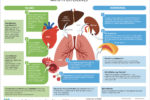Blood cholesterol levels play an important role in the development of atherosclerosis and cardiovascular disease (CVD), and the incidence of CVD is closely related to the concentration of the specific lipoproteins in the blood. In this article, we review the role of different lipoproteins and the mechanism of action and potential role of a new agent for lipid modification – Tredaptive.























